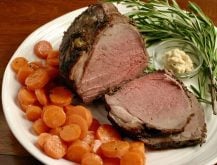I’m sure you have noticed that there are night people and morning people. Usually, when a couple of people live together, one is a morning person and the other a night person. It’s the same problem as when one likes the thermostat turned up and the other likes it turned down.
I’ve always wished I was a morning person. My grandmother got up really early and had all her work done by noon, and then wonder what she would do the rest
of the day.
Read Also

Intergenerational rollover rules can help succession plans
One of the most significant concerns in succession planning for farmers is the tax bill that can come with passing the farm to the next generation.
I never run out of things to do. It seems like morning
people accomplish more in a day. Also, I know that mornings are a beautiful time of the day and that I miss half of it.
You’d think it would be easy to change, but all efforts on my part have failed.
Another disadvantage to being a night person is that it is a long time from supper to bedtime and hunger sets in. The University of California, Berkeley, Wellness Letter tells us that there is nothing bad about a healthy bedtime snack, such as a bowl of cereal or a piece of fruit.
It reports that studies on the effect of timing of meals on weight gain have had confusing results. Some find that eating at bedtime has no effect on weight gain while others have contrary results.
Some of the studies that link nighttime eating with weight gain have been done with obese people, who may tend to
overeat at night. People sitting in front of the TV with high-calorie snacks at hand may also tend to overeat, but it’s not the time of day that causes them to gain weight.
If you are not overweight or putting on excess pounds, you shouldn’t worry about a bedtime snack. Many people find it helps them sleep. If you are gaining weight,
re-evaluate whatever you eat throughout the day, both meals and snacks, and trim calories where you can.
Mars Bar squares revisited
Dear TEAM: It was great to see the
recipe for Mars Bar squares in your
column (July 7/05). My mom and I have been making those squares for years,
but we add one cup (250 mL) marshmallows when melting the butter and
chocolate bar. We also tend to use closer to four cups (one L) Rice Krispies
rather than three cups (750 mL). The
marshmallows add a great texture to the squares. – S.M., Gibbons, Alta.
Thanks S. M. This is the recipe with the changes suggested.
Mars Bar squares
3 Mars Bars
1/2 cup butter or margarine 125 mL
1 cup marshmallows 250 mL
4 cups Rice Krispies 1 L
1 cup chocolate chips 250 mL
1 tablespoon butter 15 mL
or margarine
Melt Mars Bars, 1/2 cup (125 mL) butter or margarine and marshmallows in microwave on high for 1-11/2 minutes. Stir partway through the heating.
Add Mars Bar mixture to Rice Krispies. Set in a eight x eight inch (20 x 20 cm) pan.
Melt chocolate chips and one tablespoon (15 mL) butter or margarine by heating in the microwave on high for approximately 30 to 40 seconds. Remove from the microwave and stir until the chips are melted. Put on top of the Rice Krispies mixture. Cool and slice.
Note: Do not use light margarine in this recipe because it contains too much water. The Rice Krispies mixture will not set and the melted chocolate for the icing will become stiff and unspreadable.
When melting any chocolate, avoid getting even a few drops of water in it because it will stiffen the mixture.
Yield: 25 squares.
Baby carrots
Miniature peeled carrots in cello packs now account for one-third of all carrots sold. Carrot consumption has increased because of packaged baby carrots.
Are these “baby carrots” as nourishing
as the good old-fashioned carrots? The answer is yes. First, though, they aren’t really baby carrots. They are regular carrots that have been peeled and cut down. This was
the brilliant idea of a farmer in Bakersfield, California, who sought to maximize his carrot crop and use broken or knobby
vegetables.
Breeders then created newer carrot varieties with an improved cylindrical shape better suited to being cut up. They are longer and sweeter. Carrots that don’t make the cut are turned into juice or cattle feed, so everybody benefits.
Carrots are the original “good-for-you” vegetable. They are cheap, sturdy, tasty whether raw or cooked, and a storehouse of fibre and beta carotene. They offer some lutein, vitamin C and potassium as well.
Baby carrots contain the same high
level of carotene and other nutrients as regular carrots. They cost about twice as much, but many feel they are worth it. People tend to eat more of them
because they are so handy – excellent
for lunch boxes, snacks and appetizer
trays.
Source: University of California, Berkeley, Wellness Letter, January 2005.
Christmas gifts
On Oct. 1, Jean Paré and the Company’s Coming crew launched one of their most recent books, Christmas Gifts from the Kitchen. It is a beautiful book full of coloured photographs of recipes and gift giving ideas.
The book is dedicated to making home-made presents. I especially like the box and container ideas and the creative ideas for wrapping and decorating.
“A gift from the kitchen, especially one carefully chosen to fit the occasion, makes
a statement”, Paré said.
“In these days when so many of us struggle to find some spare time in our busy lives, this message is especially meaningful.”
There are more than 180 recipes in Christmas Gifts from the Kitchen, everything from mixes to candies,
preserves and breads. These recipes provide instructions and ideas on everything we need to create heartwarming and personal gifts: gifts of our time and individuality.
Company’s Coming Christmas Gifts from the Kitchen sells for $24.99 at bookstores across Canada.
Cookbook draw
We are planning another cookbook draw for early December. Christmas Gifts from the Kitchen is one of the books included in the draw.
What does your family serve at seasonal celebrations such as Thanksgiving, Christmas, Hanukkah or New Years?
To enter the draw and share your traditions, send them by e-mail to team@producer.com or mail to TEAM Resources, c/o The Western Producer, P.O. Box 2500, Saskatoon, Sask. S7K 2C4. The deadline for entries is Dec. 6, 2005.
Alma Copeland is a home economist from Elrose, Sask., and one of four columnists comprising Team Resources. Send correspondence in care of this newspaper, Box 2500, Saskatoon, Sask., S7K 2C4 or contact them at team@producer.com.














